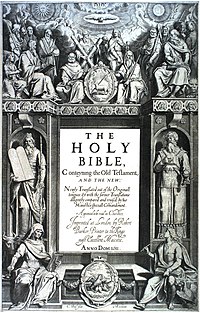Thomas Bilson
Bilson's literal views on the descent of Christ into Hell were orthodox for "conformist" Anglicans of the time, while the Puritan wing of the church preferred a metaphorical or spiritual reading.
[24][25] Much feeling was excited by the controversy, and Queen Elizabeth, in her ire, commanded Bilson "neither to desert the doctrine, nor let the calling which he bore in the Church of God, be trampled under foot, by such unquiet refusers of truth and authority.
[29] In Clink Street, Southwark, one end wall of the palace hall, containing a rose window thirteen feet in diameter, is all that now remains standing.
Being free of the county jurisdiction of Surrey, and of London, the Liberty became especially associated with the late Elizabethan theatres, and was renowned for its brothels, its gambling dens, skittle alleys and places for bear-baiting.
Rules for the regulation of the brothels were introduced by the bishops (who benefited by receiving taxes), and an unconsecrated graveyard was established for the women who had worked in them.
Among the successful men of business at Southwark was Philip Henslowe (1550–1616), who acquired interests in inns and lodging houses, and was engaged in dyeing, starch-making and the sale of wood, and in pawnbroking and money lending.
The actors' company called the Admiral's Men broke with James Burbage, of The Theatre (Curtain Road, Shoreditch) over the division of receipts, and Henslowe partnered with them, and with Edward Alleyn, from 1591.
He became increasingly autocratic, and in 1615 a company of actors brought "Articles of Grievance and Oppression against Philip Henslowe", claiming (among many other complaints) that he had said, "Should these fellowes come out of my debt I should have no rule over them.
[32] This may relate to The Globe lying in the bishop's jurisdiction, for although Ian Wilson speculated that Shakespeare may have lived within the Liberty,[33] the churchwardens there did not list him for compulsory attendance at Easter Communion.
[41] He was ex officio visitor of St John's College, Oxford, and so was called to intervene when in 1611 the election as president of William Laud was disputed, with a background tension of Calvinist versus Arminian.
[46] The outcome of the case was a divorce, and Bilson was then in favour with Robert Carr, 1st Earl of Somerset, a favourite in the court who proceeded to marry Frances.
[49] In fact, though this was the high point of Bilson's career as courtier, and secured by Somerset's influence, he had been led to expect more earlier that summer.
This misjudgement was a major step in Somerset's replacement in favour by George Villiers, said to have happened in physical terms under Bilson's roof at Farnham Castle that same August.
In 1616 John Dunbar published a book of Latin Epigrams, Epigrammaton Ioannis Dunbari Megalo-Britanni,[52] one of which is addressed to Thomas Bilson, Bishop of Winchester:"Castalidum commune decus, dignissime praesulBilsoni, æternis commemorande modis:Quam valide adversus Christi imperterritus hostesBella geras, libri sunt monumenta tui:His Hydræ fidei quotquot capita alta resurgunt,Tu novus Alcides tot resecare soles.
"(Shared ornament of the Muses, prelate most worthy,Bilson, to be renowned in ageless strains:How steadfastly against the foes of ChristYou battle, fearless, your books do testify:So many of Faith's Hydra's-heads that rise,With these our new Alcides cuts them down.
This replaces the original inscribed plate which was removed to a position on the floor against the wall between the tombs of Richard II and Edward III for its preservation.
Here lies Thomas Bilson formerly bishop of Winchester and counsellor in sacred matters of his serene highness King James of Great Britain who when he had served God and the church for nineteen years in the bishopric laid aside mortality in certain hope of resurrection 18 June 1616 aged 69.Bilson left no will, but administration of his affairs was granted to his widow Anne (died 1643, daughter of Thomas Mill or Mylles of Nursling, Hampshire, Recorder of Southampton and MP (died 1566),[55] by his wife Alice Coker of Mappowder).
[59] Henry Parker drew on both Bilson and Richard Hooker in his pamphlet writing around the time of English Civil War,[60] and Wood observed that the arguments towards disobedience in The True Difference, while they may have served Elizabeth, "did contribute much to the ruin of her successor King Charles I.
[62] His writings took a nuanced and middle way in ecclesiastical polity, and avoided Erastian views and divine right, while requiring passive obedience to authority depending on the context.

